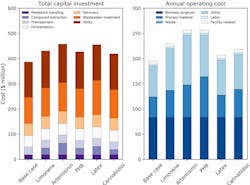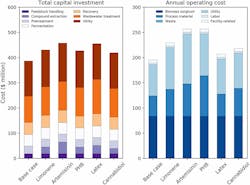Bioproducts Promise Better Biofuel Economics
Biofuels cost-competitive with fossil fuels would result if crops produce a valuable chemical that can be recovered economically, note researchers at the Department of Energy’s Lawrence Berkeley National Laboratory and Joint BioEnergy Institute (JBEI), Berkeley, Calif. The researchers now have determined exactly how much of such a bioproduct that plants would need to create to make the process of extracting it worthwhile.
Using bioproducts that plants already economically produced, Corrine Scown and Patrick Shih of JBEI designed and simulated what it would take to extract these bioproducts in the context of an ethanol biorefinery. In this setting, after extracting the valuable bioproduct from the plant, the remaining plant material would be converted into ethanol.
This approach helps determine how much bioproduct that plants must produce to make extraction worthwhile, and the amount needed to reach a target ethanol selling price of $2.50 per gallon.
Results showed that a harvest of 10 dry metric tons of sorghum biomass from an acre of land would require recovery of around 130 pounds of limonene from that biomass to meet the target. That represents an accumulation of limonene at just 0.6% of the dry weight of the biomass. An article in The Proceedings of the National Academy of Sciences provides more detail.
“The researchers in our Feedstocks Division were surprised by how modest the target levels were,” says Scown. “The levels we need to accumulate in plants to offset the cost of bioproduct recovery and drive down the price of biofuels are well within reach.”
In addition to sorghum, the team is working on switchgrass as well. “Some bioenergy crops are less genetically tractable than sorghum, which could make them more difficult to engineer for this purpose …,” notes Scown. “One might ask, ‘Why not do this with corn?’ We often model corn stover (the biomass residue leftover after grain is harvested) as a bioenergy crop. It is possible, but there is a risk of negatively impacting the ‘primary’ product (in this case, the grain),” she adds.
The team next plans to apply the economic analysis to other potential coproducts. “The goal now is to take what we’ve learned and start doing modeling more specifically focused on products that our colleagues are engineering plants to accumulate. There are a variety of compounds we are going after, so I'm not sure which ones we'll do first, but stay tuned,” comments Scown.
This ethanol-production-facility simulation highlights the total operating cost and capital investment for nonengineered biomass sorghum feedstock. Source: The Proceedings of the National Academy of Sciences.
“The exciting part of this research is that there is a huge range of targets that could be great bioproducts …,” adds Shih. “We looked at a structurally diverse set of compounds that also represent a wide range of low to high value compounds. I would hesitate to say there is an ‘ideal’ compound to go after, but taking into account the market size is important.”
Engineering efforts specific to the accumulation of bioproducts in high-yield bioenergy crops are limited but this is an active area of research, notes JBEI’s, Jenny Mortimer. “… There are a number of technical bottlenecks, such as plant transformation efficiencies, co-expressing multiple genes in specific tissue types, as well as regulatory issues. A lot of progress has been made in model systems grown in controlled environments …, but I think we’re at the beginning of understanding how this works in the field. Muconic acid is a good example of a target compound,” she says.
Forage Genetics International is working with JBEI on current and future developments. “They are collaborators on improving traits in sorghum, and have also licensed some of our technologies,” concludes Mortimer.

